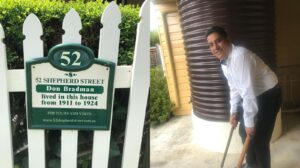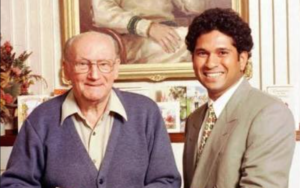
Boria Majumdar
The moment the address is mentioned, the one word that comes to mind is reverence. For this is where the greatest batsman of all time Sir Donald Bradman lived for a good 14 years between 1911-1924. Located in scenic Bowral, this house for some years was maintained by Andrew Leeming and was one of the most visited residence museums in the world. In fact, 52 Shepherd Street is one of the many Bradman things to do in Bowral.
The journey actually starts a mile before you enter the actual city. On the left hand side of the highway, tucked away in the midst of bushes, is a billboard with Bowral written on it. That’s when you first know that you are nearing cricket’s sacred pilgrimage. And once you enter the quaint little town, most things have a Bradman mention. Be it the roads, few of which are named after Bradman, or the cricket ground, which too bears the name of Sir Donald, he is the one who dominates the Bowral narrative. And the best thing is how each Bradman memory has been preserved.
Bradman Oval is easily one of the best maintained grounds in Australia and being located just next to the Bradman museum, it is an added attraction for every tourist who comes to Bowral. The museum, redone and refurbished, is a marvel. Specially curated audio visual shows, fascinating Bradman artefacts and memorabilia, a newly added section of paintings of the world’s best cricketers, the Bradman museum is one for the bucket list.
Other attractions in Bowral include the 20 Glebe Street house where Sir Don lived for four years between 1924-28. This house, too, is maintained by the Bradman Foundation and is a kind of tourist attraction.
However, the best part about a visit to Bowral is the experience with the tank stand. While the Bradman museum has a replica of it and visitors can play with a stump and a plastic golf ball, the 52 Shepherd Street house still has the original tank stand that Sir Don used to hone his skills. Multiple stumps are kept next to it and new golf balls are kept in a bucket for visitors to experience and recreate what Sir Donald used to do for hours everyday on a regular basis. And let me tell you the act isn’t easy. The golf ball can go either way and to be able to hit it with a stump is a seriously difficult act.

This is where Bradman and Sachin Tendulkar come together and become one in the process. While Sir Don honed his skills with a golf ball in Bowral in the 1910s and early 1920s, 60 years later Sachin Tendulkar did the same in Mumbai without knowing a thing about Sir Donald. Sachin had asked his aunt to shave off the sides of a golf ball and give him throwdowns, trying to perfect his defensive technique by doing so. In his words, “The golf ball with the sides shaved off could go in any direction and it was excellent practice for me. I can tell you it helped develop my backfoot play.”
As a result it is only fair that the two new additions from India to the Bowral world cricket wall are Sunil Gavaskar and Sachin Tendulkar. That Sir Don fancied watching Sachin play is well known and even invited Sachin home during the 1992 India tour of Australia.
Before leaving the Bradman museum, one is faced with a giant screen, which plays on loop some of Sir Don’s best knocks. Among them are some of his hundreds against India in 1947-48, a tour that was dominated by Bradman.
As we were driving back from Bowral, one thing stayed with me. The whole Bradman experience has now been curated and immortalised for all times to come. Can we do the same for a Gavaskar or a Tendulkar in India?
Follow Revsportz for latest sports news






